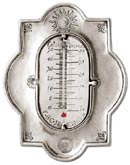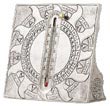In 1593, Galileo measured room temperature using a glass cylinder containing alcohol the density of which increased considerably when the temperature decreased. Glass balls of various densities with numbered tags attached to them floated in the liquid which rose or fell as the alcohol became more or less dense. The scientists of the Cimento Academy in Florence made two different kinds of thermometers and published their experiences with heat in a book. To tell the truth, rather than measuring temperatures, these thermometers only indicated variations. Thermometers were still calibrated experimentally and the various scales could not be compared. The comparable thermometer was produced later on the basis of certain fixed starting or finishing points (the temperatures of boiling water and melting ice). This led to three fundamental scales: Celsius, Réaumur, Fahrenheit and mercury was chosen as the basic substance.
Our pewter thermometers are marked with two or three fundamental scales: Celsius, Fahrenheit and Réaumur. On some articles we have patented a method that makes use of a rotating partition to make it easier to read one scale rather than another. The "minimum and maximum" thermometer features a special marker that measures the minimum and maximum temperature of a day, month or year.
Our pewter thermometers are marked with two or three fundamental scales: Celsius, Fahrenheit and Réaumur. On some articles we have patented a method that makes use of a rotating partition to make it easier to read one scale rather than another. The "minimum and maximum" thermometer features a special marker that measures the minimum and maximum temperature of a day, month or year.

|
|
Double scale thermometer
cm 16x20 8460 - IN STOCK |

|
|
Min/max termometer
cm 25x10,5 10550 - IN STOCK |

|
|
Desk - table calendar
cm 14x14 8940 - IN STOCK |

|
|
Thermometer
cm 11xh27 9600 - IN STOCK (11) |

|
|
Thermometer/lg.
cm h 25 8950 - IN STOCK |

|
|
Thermometer
cm h 19 8951 - IN STOCK |


